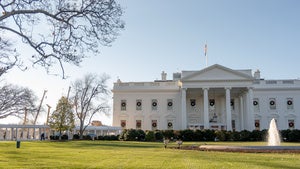How Much US Land Do China and Other Countries Really Own?

As of 2021, China owned less than 1% of all foreign-held land in the U.S. Canada, by contrast, held more than the entire area of Vermont and New Hampshire combined.
In short: In 2023, at least 81 bills banning Chinese ownership of U.S. land were introduced across 33 states, at the same time that the federal government was ramping up efforts to restrict or investigate Chinese-owned businesses like TikTok and Temu. Some legislators say Chinese ownership of U.S. land presents a national security risk, but the acreage actually held by China in the States is relatively small. As of 2021, China owned less than 1% of all foreign-held land in the U.S. Canada, by contrast, held the most at 12.8 million acres — more than the entire area of Vermont and New Hampshire combined.
Which Countries Own the Most US Land?
According to a USDA Farm Service Agency report, foreign individuals and entities had a stake in about 40 million acres of U.S. farm and forest land at the end of 2021, the most recent year for which complete data is available. That’s about 3.1% of the country’s privately held farm and forest land.
Of all foreign-owned U.S. land, Canadian investors owned the most at 12.8 million acres. This makes up 31% of all foreign-owned U.S. land.
Four other countries held 12.4 million acres combined, or another 31% of foreign-owned land: the Netherlands (12%), Italy (7%), the United Kingdom (6%), and Germany (6%). China holds less than 1%.
The remaining 15.6 million acres are split up among around 100 other countries, including India, Saudi Arabia, and Iran.
The amount of agricultural land that’s foreign-owned has grown significantly in recent years. In 2011, 26 million acres were owned by foreign investors — less than two-thirds the acreage held by foreign interests in 2021. Though USDA data since 2021 is not as substantive, it shows that this trend is continuing: In 2022, foreign-owned acreage grew to 43.4 million.
In most states, very little land is foreign-held. The exception to this is Maine, where a fifth of all privately held land is at least partially foreign-owned. Most of that land is forest controlled by Canadian owners, particularly the Canadian timber company Irving Woodlands, which owns at least 1.255 million acres in Maine, or about a third of the state’s foreign-owned land. Maine and Texas – which are the top two states for most foreign-held lands – have no laws restricting foreign ownership of land.
At the county level, Aroostook County in northern Maine has one of the highest percentages of foreign-owned land. It’s also one of the main counties where Irving operates in Maine, having owned large parcels of land in the county since at least 1999. Nearly half of Aroostook County’s 6,671 square miles are foreign-owned – but, at the national level, this is an extraordinary outlier. Most American counties have single-digit percentages of foreign landownership, or less.
Why Do They Own US Land?
According to the USDA report, almost half of all foreign-held U.S. land is timber or forest land, 29% is for crops, and 22% is pasture or other agricultural land. Only about 2% of foreign-held land is non-agricultural.
“Agricultural land can be a great investment,” said Michigan State University agriculture professor David Ortega in a Q and A with the college. “Foreign entities have bought this land for food production, energy projects such as wind or solar farms, or as an investment due to its stable growth and returns.”
In 2023, the average value of farm real estate in the U.S. hit $4,080 an acre – nearly double what it was worth in 2007.
The U.S. Government Accountability Office notes that wind farms have been a particular driver of the recent increase in foreign-held land. As the office explains, many foreign companies have begun leasing pastures and farmland in recent years to build wind turbines.
Why are Lawmakers Concerned about Chinese Landownership?
Many of the state legislators who have supported bills to limit Chinese landownership cite national security concerns — for instance, that the Chinese government could use the land to set up espionage operations or that U.S. food security could be threatened if too much farmland is bought up. This was partially sparked by an alleged Chinese spy balloon seen flying across the country in 2023.
A 2022 Chinese land purchase in the U.S. also raised concerns. That spring, a food producer called Fufeng Group bought 370 acres for corn milling near an Air Force base in North Dakota. This prompted the Biden administration to propose a new rule: any foreign company or individual who wants to buy land within 100 miles of certain U.S. military bases (the North Dakota base included) needs government approval.
While Chinese ownership of U.S. land has been a hot topic among lawmakers — even becoming the center of a Montana Senate race this year — China only had a stake in 383,935 acres of U.S. land as of 2021, which is less than 1% of all foreign-held land.
It’s worth noting that a 2023 NBC investigation found that the foreign ownership reporting system is “lax and enforcement minimal,” with some purchases not reported to the USDA for years, but there is little evidence that Chinese land ownership in the U.S. exceeds its reported boundaries by any significant margin.
In testimony to the Senate agriculture committee in September, Michigan State’s Ortega said, “China’s investments in foreign agriculture are largely driven by its desire to build food self-sufficiency.” Former USDA chief economist Joe Glauber told the Washington Post that Chinese ownership of U.S. farmland is “literally a drop in the bucket.”
Despite this, in 2023 alone, at least 81 bills were proposed across 33 states that would restrict Chinese ownership of farmland and of any land near military bases. At least one of those bills passed, a Florida law that banned those who are not U.S. citizens and are “domiciled” in China from buying land or buildings. But the bill was blocked by a U.S. appeals court in February.
Though this new wave of Chinese land restrictions is notable in its volume (and its disproportionality to the amount of land that China actually owns in the U.S.), placing some limits on foreign landownership is a fairly common practice. About half of all states have laws restricting foreign landownership in some capacity, according to the National Agricultural Law Center, and at least 11 federal bills on the topic have been proposed in the last three years.
“We expect the political rhetoric on this to escalate and also expect more legislation to be introduced and passed,” John C. Yang, president and executive director of Asian Americans Advancing Justice, told the Washington Post. “Even state legislators want to appear to be tough on China right now, and they are grasping for things that they can control in their own state legislatures to show that they are being tough.”




Related Events

Daleep Singh and Brent Neiman discuss global economic policy and macroeconomic trends in this edition of the Global Economy Roundtable Series.

Suzanne Nossel leads a webinar in partnership with the Leadership Now Project on how the US can strengthen its competitiveness in the age of AI.

Kim Ruhl and Brent Neiman discuss the Trump administration's economic policies in this edition of the Global Economy Roundtable Series.
